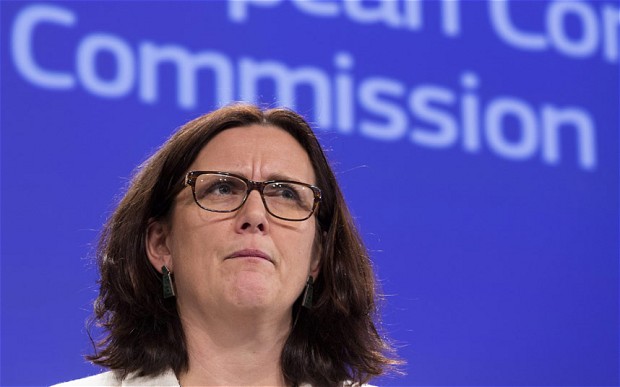
Corruption in EU is costing ‘breathtaking’ £100bn a year
February 3, 2014This Day in Jewish History / Hitler makes first call for Jews’ ‘annihilation’
February 3, 2014Poland
In the 1500s, the territory known as Poland
encompassed areas of the present nations of Poland, Lithuania, Belarus,
Ukraine, and Russia. According to legend, Jews traveling eastward from Germany
in the 900s received a Heavenly message Po-Lin, which is not only the Hebrew
name for Poland, but also means settle here. Settle they did, minting coins
with Hebrew inscriptions in Poland as early as the 1100s. At first, Jews
traveled to Poland to escape persecution and the ravages of the Black Death.
Later, Jews came from the south and east, possibly remnants of Khazar Jews.
Polish kings, needing people to inhabit their vast territories, and realizing
the economic boon that Jews bring to a country, welcomed them. Indeed, despite
occasional outbreaks of anti-Semitism, life in Poland was far more pleasant for
Jews than anywhere else. The Polish cities of Cracow, Warsaw, Poznan, Kalisz, Jews
traveled to Poland to escape persecution and the ravages of the Black Death
Brisk, and Grodno became major Jewish centers. By 1500, between 20,000-30,000
Jews lived in Poland. At the end of the 1500s, Great Poland contained 52 Jewish
communities, Little Poland 41, and the eastern regions 80. During the 1600s, it
is estimated that four-fifths of the world’s Jews resided there.
Torah Life
By the 1500s, Ashkenazic Poland became the
Torah center of world Jewry, a position it held until the Holocaust. Producing
the greatest scholars, yeshivas, and sefarim, Poland played a dominant role in
Torah scholarship up to the contemporary era. Great movements within
traditional Judaism, such as Chassidus and Mussar, originated in Poland. Due to
the relative absence of oppression, and the complete lack of assimilation with
the unattractive, backward Polish culture and society, Jewish spiritual life
flourished in Poland. Even ordinary people spent many hours studying Torah,
creating a society where Torah was paramount. Some great Polish scholars of the
1500s include:
Rabbi Moshe Isserles (Rema)
Born in Cracow, Rema was regarded
as the leader of Ashkenazic Jewry. His greatest accomplishment was his critical
notes on the Shulchan Aruch of Rabbi Joseph Karo. The Shulchan Aruch reflected
Sephardic practice, and in numerous instances Ashkenazic custom differed. Rema
humbly called his notes Mapah, a tablecloth for the Shulchan Aruch, the set
table. He pointed out where Ashkenazim diverged, thus enabling them to be loyal
to their traditions but also benefit from Rabbi Joseph Karo’s masterpiece.
Incredibly, Rema wove his notes into the text of the Shulchan Aruch, thus
preserving the integrity of the original work. Sephardim read the Shulchan
Aruch without Rema’s notes, while Ashkenazim read the same text with those
notes, and both readings make perfect sense. No other author in history can
boast of such a literary accomplishment. Rema died in Cracow, and his grave and
synagogue still exist today, miraculously surviving the Holocaust
unscathed.
Maharsha (Moreinu Harav Rav
Shmuel Aidels)
This scholar, financially
supported by his wealthy mother-in-law Aidel, took her name as an honorific.
Maharsha’s commentary on the Talmud is the sine qua non of absolute logic, and
its study is required for clear understanding of Gemara, and particularly of
Tosafos. The Chazon Ish, the leading Lithuanian scholar in Eretz Israel of the
20th Century and who passed away in 1953, wrote that if one does not study
Maharsha’s work, he has but a superficial knowledge of the topic at hand.The issues he raises bear an uncanny resemblance to current
times
Maharsha also wrote a commentary on the non-legal passages (Aggadah) of the
Talmud, which, although written in a very different style, is indispensable for
understanding those sections. A glimpse of some of the social and religious
problems of Polish Jewry in the 1500s can be seen in a famous statement of
Maharsha, yet the issues he raises bear an uncanny resemblance to current
times:
“Many
people are unaware of the intricate laws of the Sabbath, and constantly violate
it. On Saturday nights, many Jews see it as a religious obligation to waste
time in frivolous pursuits, and awaken on Sunday too late to recite the Shema.
During school vacations, youths spend vast amounts of time in the street in
purposeless pursuits. Everyone wants to flaunt their wealth by building
palatial mansions, wearing expensive clothing, and [engaging] in all manners of
conspicuous consumption. People are dishonest in monetary affairs, and rabbis
who speak out regarding the excesses of society are scorned.”
Rabbi Shlomo Luria (Maharshal)
This eminent scholar, a
contemporary of Rema and Maharsha, also wrote a commentary on Talmud in which
he frequently disagrees with Maharsha.
One of Maharshal’s well-known works, Yam Shel Shlomo, is a halachic
compendium on many Talmudic tractates. A very famous ruling contained therein
is the requirement that a Jew must sacrifice his or her life rather than
falsify even one word of the Torah.
Rabbi Joel Sirkes and Rabbi Meir of Lublin
Rabbi Joel, popularly known as
the Bach after his analysis of the Tur called Bayis Chadash, is one of many
Acharonim called by the title of his most important scholarly work rather than
by his name. For example, Rabbi Israel Meir Kagan is known as the Chafetz
Chaim, the title of his masterpiece on the laws of lashon hora — evil gossip.
Rabbi Meir, called Maharam, is best known for his commentary on the Talmud.
Maharam’s commentary is similar to that of Maharsha, but is written is a much
simpler style. Maharam, too, plays an important role in understanding the topic
at hand.
Va’ad Arba Aratzos
With the permission of the
authorities, about 1520 the Jews of Poland organized an umbrella organization
known as Va’ad Arba Aratzos, the Council of the Four Lands. Rabbis were chosen
from the four major Polish provinces — Great Poland, Little Poland, Volhynia,
and Podolia. For a time, rabbis from Lithuania also participated, and the
council was known as Va’ad Chamesh (five) Aratzos. The Va’ad met twice a year,
in Lublin after Purim, and in Yaroslav before Rosh HaShanah. As these two
cities were major market centers, they attracted many merchants and scholars.
Major litigation was decided then, such as disputes between merchants or towns,
along with the determination of which areas would pay what proportion of the
king’s taxes on the greater Jewish community. By consent of each area’s
representatives, decrees applicable to all Polish Jewry were also enacted. As
such, the Va’ad had enormous prestige, and was considered not only the de facto
Jewish parliament, but also a replica of the Great Sanhedrin. As an example of
the far-reaching powers of the Va’ad, one pronouncement states that:
“It
is forbidden for any Jew to rent the collection rights for taxes on whiskey or
any other taxes from the king. One who violates this shall be excommunicated
from this world and the next, and has no connection to the Jewish people. His
bread and wine should be considered as that of non-Jews, his slaughter is
invalid, no Jew should marry his children and no rabbi should officiate at such
a ceremony, and he should not be afforded a Jewish burial. All the curses
written in the Scriptures should take effect on him until he repents of his
evil ways.”
Another
ordinance of the Va’ad prohibited rabbis from offering payment to obtain a
rabbinical position. The Polish government abolished the Va’ad in 1764.
Jewish Economic Activity
In the 1300s, King Casimir the
Great invited Jews to Poland, giving them special economic privileges
reconfirmed by subsequent Polish kings. Not restricted by any discriminatory
laws, Jews became the middle class of Poland, filling a gap in a Polish societyJews became the middle class of Poland
that was composed of wealthy landowners and landless serfs. Jews became horse
and cattle traders, cloth dyers, metal workers, artisans, tailors, and
jewelers. They owned taverns, lent money, managed the vast estates of the
noblemen, (the infamous poritzim of many Jewish tales) and collected taxes.
Such a complete Jewish dominance of Polish economic life aroused great
resentment among the gentile population, an antipathy augmented by the people’s
fervent Christianity. These attitudes would later have disastrous ramifications
for the Jews of Poland.
The Shtetl
The word shtetl is Yiddish for
small town, and in Poland many Jews wound up settling in tiny hamlets, both to
escape the overcrowding of the large cities and to band together in the vast
stretches of the wild eastern provinces.
Due to the tranquil surroundings and isolation from alien influences,
shtetl life was conducive to intense Torah study and spiritual achievement;
indeed, many of the greatest scholars were products of the shtetl. Over time,
the greatness of the Eastern European Jews was realized in the shtetl, and the
beauty of its lifestyle, and spiritual grandeur, were a source of strength
until the shtetls were irrevocably destroyed in the Holocaust.
Maharal of Prague
One of the most famous Jewish
thinkers of all time, Rabbi Judah Loew, more commonly known as Maharal, held
several prestigious rabbinical posts, most notably in 16th-century Prague. Best
known for the Kabbalistic creation of a Golem, a clay being with human
characteristics who aided Rabbi Loew in combating blood libels and other plots
against the Jews, the Maharal’s prolific literary output combined aspects of
both philosophy and Kabbalah, and influenced both the Mussar and Chassidic
movements. Maharal’s writings are still popular today, having lost none of
their profound intellectualism or timeless appeal. A statue of Maharal was
erected in Prague in 1917 and still stands today.
Prague
Known as a mother city of the Jewish people,
over hundreds of years Prague boasted one of the greatest Jewish communities in
Europe. From the time of the Rishonim, many great scholars lived in Prague. The
city’s most famous site is the Altneushul, built in 1265 and stands as the
oldest synagogue in Europe. The name Altneu may come from the Hebrew Al Tnai,
meaning on condition, signifying that the synagogue was built with the
understanding that it would only be used until the Messianic era, when Jews
would return to Eretz Israel. Maharal was rabbi in this synagogue, and the
Golem is supposedly buried under a pile of discarded sacred objects (shaimos)
in the attic, which for hundreds of years Jews have not entered. Other famous
shuls are the Pinkas and Klaus synagogues, both hundreds of years old. The
ancient Jewish cemetery has rows of bodies 16 deep due to the limited burial
space, and contains some of the gravesites of Prague’s most famous rabbis. The
city escaped destruction during World War II, and the Nazis, who planned to
establish the Museum of the Extinct Jewish Race in Prague after they destroyed
the Jewish people, left the Jewish quarter intact.
Other Torah Centers
In the 1500s, Frankfurt, Germany;
Salonika, Greece; and Constantinople and Smyrna, Turkey, were all major Torah
centers. These cities were heavily populated by Jews and attracted great
scholars who welcomed the challenges of prestigious rabbinical posts. These
cities also contained printing presses for the dissemination of Torah works.
Other areas of significant Jewish population at the time included Italy,
Germany, Holland, and North Africa.
Overall, the
1500s were a time of great change and enormous accomplishment in the Jewish
world. It was a century in which the foundation of Jewish life for the next
several hundred years was set.


